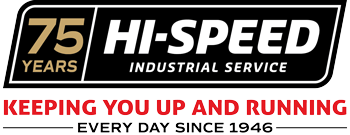While it’s evident that every electric motor or rotating equipment requires regular lubrication to operate efficiently, not all lubricants and lubrication systems are equal. For example, simple grease lubrication may suffice in some cases, while other situations require complex circulating oil systems and specific oil blends.
When selecting the proper lubricant for your electric motors and rotating equipment, a thorough understanding of each option’s pros and cons is essential. Using the wrong delivery system, viscosity, weight, additives, or type of oil/grease could harm the component’s performance and lifespan. So today, we’ll discuss the two different types of conventional and automatic lubrication systems available for rotating equipment and electric motors.
Conventional Electric Motor Lubrication Methods
These lubrication systems apply consistent lubrication to rotating machinery and parts at a controlled rate to reduce heat, friction, and premature wear. However, the first step should be to consult the manufacturer’s literature for their recommendations and warranty requirements.
Grease lubrication
These semi-solid lubricants are easily recognizable due to their thick and viscous composition. Because grease is not fluid like oil; it stays in place to provide corrosion protection, prevent wear, and reduce friction. However, due to density, grease is not ideal for reducing heat build-up in rotating equipment and machinery. Therefore, grease is typically pre-packaged into tubes that fit into a hand or mechanical grease gun for easy usage. Application via spray machines and aerosol form are other options.
Splash oil feed system
Many people are familiar with the splash oil feed system, an integral feature of most internal combustion engines. This system requires an oil-tight connection between the oil pan or storage component and the engine. As the internal parts cycle through their movement, oil is carried or “splashed up” onto the moving parts at the top of the motor. As gravity draws the back down to the pan, it lubricates and cools the motor bearings and bushings. Use with caution on high-speed motors, as the excessive rotations can “churn” the oil, reducing its lubrication and cooling effectiveness.
Drip oil feed system
This electric motor lubrication system is ideal for low- and moderate-speed equipment. Using an easily accessible and refillable oil reservoir, oil gets delivered via a supply tube or manifold at a constant controlled rate. The needle valves installed at each lubrication point allow the operator to quickly adjust the amount of supplied oil based on the rotating equipment’s load and speed.
Reservoirs that service only one bearing/bushing are referred to as a single-point system, while one reservoir servicing several bearings/bushings are called a multiple-point system. A drip oil feed can also be pressurized to supply oil to a bearing system operating under pressure.
Forced oil feed system
This motor lubrication system is ideal for high-speed equipment like compressors, gearboxes, boiler feed pumps, and turbine generators. The higher the operating speed, the more oil is needed to dissipate the excessive heat build-up.
A continually operated system forces oil from the gearbox to the reservoir. The oil pump pressurizes the oil before delivery to the component—the delivered oil cycles through an oil cooler before returning to the gearbox to repeat the process.
Automated Lubrication Systems
Automated systems deliver a precise amount of lubricant at short and frequent intervals while the equipment runs. Ideal for operational electric motors and equipment with accessibility issues, facility managers with time constraints, or limited human resources, automated lubrication systems are hard to beat for their lowering operating costs.
All automatic systems utilize the following components:
- Reservoir/Pump assembly for storing and supplying the required lubricant.
- Controller to activate/control the system via connection to a POS system.
- Supply lines carry the oil to and from the pump and valves.
- Metering valves/injectors to measure and release the oil.
- Feed lines to connect the injectors to the application points.
Depending on your business and manufacturer requirements, automated oil systems are available in one of the following manners.
Single-line parallel utilizes one line to deliver and return the oil, while the automated valves control the pressure and direction the oil travels.
Double line parallel is the same as above but uses two lines to supply the oil from or return the oil to the reservoir.
Multipoint direct incorporates an auxiliary drive motor to open and close the cams to dispense the oil at precise lubrication points.
Advantages of Automated Lubrication Systems
While automated lubrication systems require a slightly higher initial investment than manual methods, the owner can quickly recoup those costs.
- Managers can follow warranty requirements and service recommendations to the letter without the risk of human injury.
- Every critical component receives the precise amount of lubrication as needed.
- Safer operating conditions due to proper maintenance.
- Less friction lowers energy consumption month after month.
- Lubrication occurs while the motors and machines are operational.
- Increased production/productivity due to reduced downtime for repairs.
We’re happy to answer your questions if you would like to learn more about conventional or automatic lubrication systems for your company’s electric motors or rotating equipment. You can call us when it’s convenient for you at 1-800-713-0103, or you can send an email to the Hi-Speed team.

